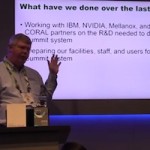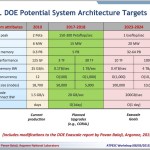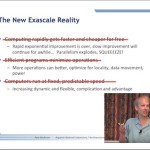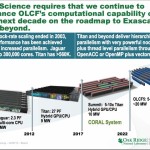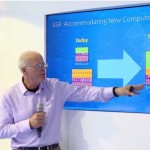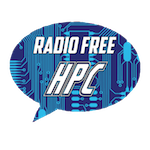Buddy Bland from ORNL presented this talk at SC15. “Summit will deliver more than five times the computational performance of Titan’s 18,688 nodes, using only approximately 3,400 nodes. Each Summit node will contain multiple IBM POWER9 CPUs and NVIDIA Volta GPUs all connected together with NVIDIA’s high-speed NVLink and a huge amount of memory.”
Video: Network Architecture Trends
Pavan Balaji from Argonne presented this talk at the Argonne Training Program on Extreme-Scale Computing. “More cores will drive the network, with more sharing of the network infrastructure. The aggregate amount of communication from each node will increase moderately, but will be divided into many smaller messages.”
Pete Beckman Presents: Exascale Architecture Trends
“Argonne National Laboratory is one of the labs helping to lead the exascale push for the nation with the DOE. We lead in a numbers of areas with software and storage systems and applied math. And we’re really focusing, our expertise is focusing on those new ideas, those novel new things that will allow us to sort of leapfrog the standard slow evolution of technology and get something further out ahead, three years, five years out ahead. And that’s where our research is focused.”
Video: Present and Future Leadership Computers at OLCF
In this video from the 2015 OLCF User Meeting, Buddy Bland from Oak Ridge presents: Present and Future Leadership Computers at OLCF. “As the home of Titan, the fastest supercomputer in the USA, OLCF has an exciting future ahead with the 2017 deployment of the Summit supercomputer. Summit will deliver more than five times the computational performance of Titan’s 18,688 nodes, using only approximately 3,400 nodes when it arrives in 2017.”
Experts Focus on Code Efficiency at ISC 2015
In this special guest feature, Robert Roe from Scientific Computing World explores the efforts made by top HPC centers to scale software codes to the extreme levels necessary for exascale computing. “The speed with which supercomputers process useful applications is more important than rankings on the TOP500, experts told the ISC High Performance Conference in Frankfurt last month.”
Advancing HPC with Collaboration & Co-design
In this special guest feature from Scientific Computing World, Tom Wilkie reports on two US initiatives for future supercomputers, announced at the ISC in Frankfurt in July.
Coral and Intel’s Scalable System Framework – The Path to Exascale
“HPC has reached an inflection point with the convergence of traditional high performance computing and the emerging world of Big Data analytics. Intel’s HPC Scalable System Framework enables an unprecedented level of system balance, performance, and scalability necessary to meet the demands of bot compute- and data-intensive workloads, today and well into the future.”
Video: Argonne Presents HPC Plans at ISC 2015
“In April 2015, the U.S. Department of Energy announced a $200 million supercomputing investment coming to Argonne National Laboratory. As the third of three Coral supercomputer procurements, the deal will comprise an 8.5 Petaflop “Theta” system based on Knights Landing in 2016 and a much larger 180 Petaflop “Aurora” supercomputer in 2018. Intel will be the prime contractor on the deal, with sub-contractor Cray building the actual supercomputers.”
Steve Oberlin on How NVLink will Power Coral Supercomputers
NVlink will be the backbone of 150 Petaflop Coral supercomputers coming to ORNL and LLNL. As the world’s first high-speed GPU interconnect, NVLink will let data move between GPUs and CPUs 5-12 times faster than possible today.
Radio Free HPC Looks at the Aurora Supercomputer Coming to Argonne in 2018
In this podcast, the Radio Free HPC team looks at the 180 Aurora supercomputer coming to Argonne in 2018. “As the third of three Coral supercomputer procurements, the deal will comprise an 8.5 Petaflop “Theta” system based on Knights Landing in 2016 and a much larger 180 Petaflop “Aurora” supercomputer in 2018. Intel will be the prime contractor on the deal, with sub-contractor Cray building the actual supercomputers.”

